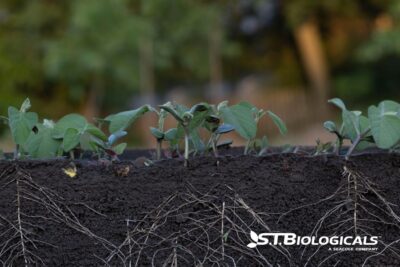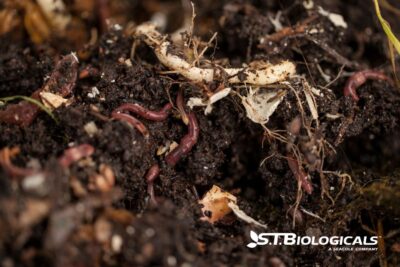Ag nanotechnology is transforming modern agriculture by making nutrient delivery more precise and efficient while supporting soil health. When combined with soil biology and other regenerative practices, it helps farmers reduce inputs, prevent nutrient loss, and improve crop resilience to environmental stress.
Scientists and farmers have known for a long time that soil microbial life plays a vital role in the consumption and regeneration of resources in the environment. Soil microorganisms are dynamic nutrient cyclers. They are considered a major tool for efficient nutrient cycling.
Agricultural practices have used biologicals as soil amendments for many years. But in the last decade, ag innovations have made nutrient cycling more efficient.
There are many tools like precision farming which allows farmers to use less inputs based on acre, field, or even row needs. GPS is only one tool in the modern farmer’s toolkit.
Ag nanotechnology is another tool that increases the efficiency of nutrient uptake by plants. When the interplay of soil biology, nanoparticles, and nutrients is understood, precision farming can be even more cost-effective. The loss of added nutrients from leaching can be all but stopped.
Let’s look at some of the interactions going on under our feet. At the micro and nano levels, a great deal of activity takes place.
What Is Ag Nanotechnology?
But first, let’s back up and briefly explain what nanotechnology is. Nanotechnology is the science of working with materials at an incredibly small scale. Nano materials are measured in nanometers. That’s one billionth of a meter. A single sheet of paper is approximately 100,000 nanometers thick!
In agriculture, nanotechnology helps farmers use fewer resources, protect the environment, and grow healthier crops. It is used to slowly release fertilizers or pesticides right where plants need them. This reduces waste and pollution. Other nanotechnology ag innovations can detect plant diseases early and purify water. In this blog, we are going to focus on one other important use of this tech: delivering nutrients more precisely.
Nutrient Cycling with Chemical Inputs
Many commodity crops have been bred for high yields, but that characteristic means they also use a lot of nutrients. Fertilizers are still necessary to optimize these high-yield crops. For example, high-yield corn and cotton utilize a lot of chemical inputs that degrade soils.
Most chemical inputs have to be converted to plant-available forms by soil biology. Soil biology and plants exist in a symbiotic relationship. Soil microorganisms depend on root exudates from plants for carbon. In exchange, they give the plant nutrients from the soil in plant-available forms. Plants can scavenge nutrients from chemical inputs for growth, but could crops be healthier without chemical inputs?
Ag Nanotechnology and Soil Health
Here’s where nanotechnology comes in. Nano products break down fertilizers into their molecular components. This provides plants with more nutrients in a form they can use with less disruption of the plant/microorganism symbiosis. It also leaches fewer nutrients into the soil.
The interactions between nanoparticle materials with soil biology can be positive or negative. It depends on the type of nanomaterial. Carbon-based nano particles capture the essential work biology performs. Nano particles capture the broken down minerals in the soil and residue and hold them in a more readily exchangeable form for crops. They also capture the biological secretions and excretions essential for producing sugars, enzymes, and amino acids.
Nanotechnology and Environmental Stress Factors
Increased resistance to environmental stresses in plants is one of the biggest benefits of nanotechnology for farmers and ranchers. The ability to resist these types of stresses is essential as extreme weather events increase in frequency.
A recent study of crops grown in saline environments showed significant stress reduction when silicon nanotechnology was added as a soil amendment. Plants had increased photosynthetic ability, higher relative water content and water use efficiency, an enhanced antioxidant system, and higher chlorophyll, carotenoid, and proline levels. (1) In this case, the silicon nano product helped plants thrive, despite a more hostile soil environment.
Nanotechnology, when applied properly, can be an important tool in your farmer’s toolkit. Along with other regenerative ag practices, it can help you reduce your inputs, improve yields, and put less strain on your land. At ST Biologicals, our mentors can help you determine the nano products that are best for your operation. Reach out today for personalized support. We’re here to help you succeed. When soil speaks, we listen.
Ag Nanotechnology FAQs
What is ag nanotechnology?
Ag nanotechnology uses extremely small particles to deliver nutrients directly to where plants need them, improving efficiency and reducing waste.
How does nanotechnology support soil health?
Nano products help break down fertilizers into forms plants can use more easily, minimizing nutrient leaching and maintaining the natural balance between plants and soil microbes.
Can nanotechnology reduce the need for chemical fertilizers?
Yes. Because nutrients are delivered more precisely and efficiently, farmers can use smaller amounts of fertilizer while achieving the same or better results.
How does nanotechnology help plants handle stress?
Studies show that nano-based soil amendments, such as silicon nanoparticles, can help plants better tolerate drought, salinity, and other stressors by improving water use efficiency and photosynthetic performance.

